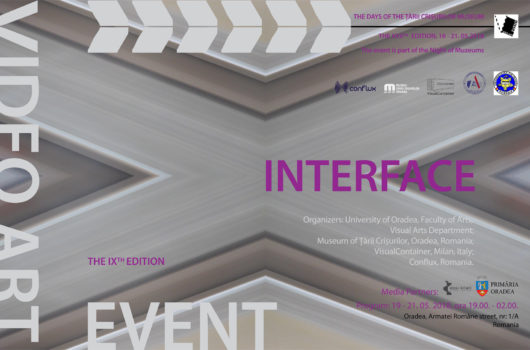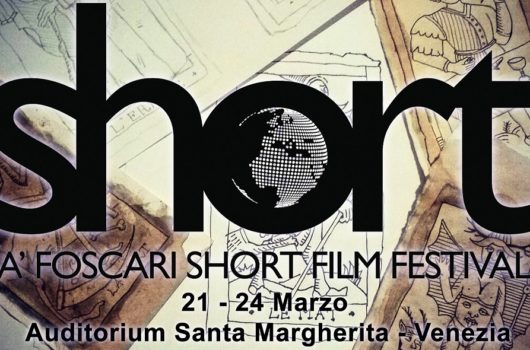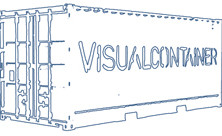
INTERFACE |Video Art Event, IXth edition
Curator: Associate Professor Dr. Gabriela Diana Bohnstedt Gavrilas
Visualcontainer’s Selection
The Museum of Tarii Crisurilor, Oradea – Romania
the White Night of Museums
19-20th of May 2017
7.pm – 02.pm
In cooperation with:
University of Oradea – Faculty of Arts – Department of Visual Arts
The Museum of Tarii Crisurilor, Oradea, Romania
Conflux Oradea (Romania)
Visual Container, Milano (Italy)
VisualcontainerTV International Videoart webchannel
[.BOX] Videoart Project Space Milano (Italy)
Artists: Lino Strangis – Flavio Scutti – Debora Hirsch – Cristobal Catalan – Sonia Armaniaco – Barbara Brugola – Lucia Veronesi
INTERFACE*
*
1. A point where two systems, subjects, organizations, etc. meet and interact.
‘the interface between accountancy and the law’
1.1 Physics: A surface forming a common boundary between two portions of matter or space, for example between two immiscible liquids.
‘the surface tension of a liquid at its air/liquid interface’
2. Computing: A device or program enabling a user to communicate with a computer.
2.1 A device or program for connecting two items of hardware or software so that they can be operated jointly or communicate with each other.‘an application program interface’”.
Oxford dictionary
https://en.oxforddictionaries.com/definition/interface
“Being able to tridimensionally process images on digital devices allows the video artist to materialize his/her ideas through philosophical approaches of the virtual space, approaches that consider reality the base for future premises.
The interface must be understood not pejoratively, as a superficial surface or a simulation without any conceptual consistency, but as a succession of images representing the same object of reference, transformed in different ways by the artist without losing the concept.
Our proposal is to create hypothetical universes, alternative realities characterized by flexibility and conexions simultaneous to the imaginary world; realities that elude physical, ideological, aesthetic restrictions.
In this manner, the artist selects from the environment and its belonging phenomena, certain features that he/she will eventually either simplify or enrich with abstract elements belonging to the virtual space. Using diverse digital instruments, the artist delivers the idea that dominates the concept of the video project.
The result is an Interface that structures access to the succession of the created video images, that does not depend upon the researched reality because it evolves differently based on the video artist’s subjective and autoreferential choices.
Thus, two apparently contradictory worlds fusion and meet in the world of ideas and they become encrypted, transformed and reinterpreted inside the features and the concept of the future video art film. Although the reality we refer to hallmarks the artistic/aesthetic concept depending on the artist’s choices and attitudes, on his/her perspective on the referential element, the mark that is based on reality will not be visible any longer and therefore, the new image questions the credibility aspect.
The thus created video art brings into discussion the issue of promoting through images the way of perceiving reality through subjectivity, game, scenario, multiple hyper-realities and simulation inside the created virtual space. The end is the destruction of overused conventions on image interpreting; the traditional way of thinking is changed and prejudices about the image itself, about the relation between real and imaginary space, are broken.
We discover, therefore, a virtual labyrinth of ideas that counts on the numerous self-referential elements, apparently simultaneous and arbitrary, dominated by an aesthetic, conceptual chaotic diversity; contrary to this, the video image is an interface between reality and the artist’s video-conceptual subject.”
Curator: Associate Professor Dr. Gabriela Diana Bohnstedt Gavrilas
Visualcontainer’s selection:
Lino Strangis – The dance of wired emotions, 5:15, 2016
Flavio Scutti – Rides, 5:26, 2016
Debora Hirsch ETIX, 1:33, 2003
Cristobal Catalan – Space Scream, 8:00, 2017
Sonia Armaniaco – Disturbed glance – 2:48, 2015
Barbara Brugola – Loop, 8:38, 2017
Lucia Veronesi – Seduti nell’oscurità è tutto più chiaro, 4:00, 2017
Special thanks to: Dott.ssa Gabriela Diana Bohnstedt Gavrilas, Dr. Aurel Chiriac and Tibi Fekete

INTERFACE |Video Art Event, IX edizione
Curatore: Associate Professor Dr. Gabriela Diana Bohnstedt Gavrilas
Selezione a cura di Visualcontainer
Museo Tarii Crisurilor, Oradea – Romania
Notte Bianca dei Musei
19-20 Maggio 2017
19.00 – 02.00
In collaborazione con:
University of Oradea – Faculty of Arts – Department of Visual Arts
The Museum of Tarii Crisurilor, Oradea, Romania
Conflux Oradea (Romania)
Visual Container, Milano (Italy),
VisualcontainerTV International Videoart webchannel
[.BOX] Videoart Project Space Milano (Italy)
Artisti: Lino Strangis – Flavio Scutti – Debora Hirsch – Cristobal Catalan – Sonia Armaniaco – Barbara Brugola – Lucia Veronesi
INTERFACCIA*
*
1. Un punto in cui due sistemi, soggetti, organizzazioni, ecc. Si incontrano e interagiscono.
‘L’interfaccia tra contabilità e legge’
1.1 Fisica: una superficie che forma un confine comune tra due parti di materia o spazio, ad esempio tra due liquidi immiscibili.
“La tensione superficiale di un liquido nella sua interfaccia aria / liquido”
2. Computing: dispositivo o programma che consente a un utente di comunicare con un computer.
2.1 Un dispositivo o programma per connettere due elementi hardware o software in modo che possano essere azionati congiuntamente o comunicati tra loro. Un’interfaccia del programma applicativo ‘”.
Dizionario di Oxford
https://en.oxforddictionaries.com/definition/interface
“La capacità di elaborare tridimensionalmente le immagini su dispositivi digitali consente al video artista di materializzare le proprie idee attraverso approcci filosofici dello spazio virtuale, approcci che considerano la realtà la base per le premesse future.
L’interfaccia deve essere intesa non in modo peggiorativo, come una superficie superficiale o una simulazione senza alcuna coerenza concettuale, ma come una successione di immagini che rappresentano lo stesso oggetto di riferimento, trasformate in modi diversi dall’artista senza perdere il concetto.
La nostra proposta è quella di creare universi ipotetici, realtà alternative caratterizzate da flessibilità e conioni simultanee al mondo immaginario; realtà che eludono restrizioni fisiche, ideologiche, estetiche.
In questo modo, l’artista seleziona dall’ambiente e dai suoi fenomeni di appartenenza, alcune caratteristiche che alla fine semplificherà o arricchirà con elementi astratti appartenenti allo spazio virtuale. Utilizzando diversi strumenti digitali, l’artista offre l’idea che domina il concetto del progetto video.
Il risultato è un’interfaccia che struttura l’accesso alla successione delle immagini video create, che non dipende dalla realtà ricercata perché si evolve in modo diverso in base alle scelte soggettive e autoreferenziali dell’artista video.
Così, due mondi apparentemente contraddittori si fondono e si incontrano nel mondo delle idee e vengono crittografati, trasformati e reinterpretati all’interno delle caratteristiche e del concetto del futuro film d’arte video. Sebbene la realtà ci riferisca a caratterizzare il concetto artistico / estetico a seconda delle scelte e degli atteggiamenti dell’artista, sulla sua prospettiva sull’elemento referenziale, il marchio che si basa sulla realtà non sarà più visibile e quindi, la nuova immagine si interroga l’aspetto della credibilità.
La video arte così creata mette in discussione il problema di promuovere attraverso le immagini il modo di percepire la realtà attraverso la soggettività, il gioco, lo scenario, molteplici iper-realtà e simulazione all’interno dello spazio virtuale creato. Il fine è la distruzione di convenzioni abusate sull’interpretazione di immagini; il modo di pensare tradizionale è cambiato e i pregiudizi sull’immagine stessa, sulla relazione tra spazio reale e spazio immaginario, sono infranti.
Scopriamo, quindi, un labirinto virtuale di idee che conta sui numerosi elementi autoreferenziali, apparentemente simultanei e arbitrari, dominati da una diversità caotica estetica e concettuale; al contrario, l’immagine video è un’interfaccia tra la realtà e il soggetto video-concettuale dell’artista “.
Curatore: Professore associato Dr. Gabriela Diana Bohnstedt Gavrilas
Selezione di Visualcontainer:
Lino Strangis – The dance of wired emotions, 5:15, 2016
Flavio Scutti – Rides, 5:26, 2016
Debora Hirsch ETIX, 1:33, 2003
Cristobal Catalan – Space Scream, 8:00, 2017
Sonia Armaniaco – Disturbed glance – 2:48, 2015
Barbara Brugola – Loop, 8:38, 2017
Lucia Veronesi – Seduti nell’oscurità è tutto più chiaro, 4:00, 2017
Un ringraziamento a : Dott.ssa Gabriela Diana Bohnstedt Gavrilas, Dr. Aurel Chiriac e Tibi Fekete

Ca ‘Foscari Short Film Festival – The Suspended Look
Video selection by Visualcontainer
March 22, 2018, 3.00 pm
Santa Margherita Auditorium
Ca ‘Foscari University Venice
Department of Philosophy and Cultural Heritage
Malcanton Marcorà, Dorsoduro 3484 / D – 30123
Also for this year’s edition of the Short Film Festival The Suspended Glance video art program may count on the collaboration of Alessandra Arnò, co-founder of Visualcontainer Italian Videoart Plaftorm and director of VisualcontainerTV, and will present a selection of videos with a narrative approach closer to the filmic and “imaginary” concept.
It is almost like re-visiting the most important moments of the history of cinema. There is an outstanding continuity between past and present, it is incredible to observe how the narrative elements are combined in a way that makes them the same but at the same time different.
From the split screen to the reinvention of the “coming soon” or trailers, to the nightly sequence, a fragment of life that becomes exemplary, to the great care for the technique, but above all the unavoidable connection with the audio, shows how the video artist can also draw inspiration from the past with the intention of interpreting the present. Although in a very short time the elements that question, disturb and anguish the contemporary man are made manifest with immediacy, a peculiar characteristic of video art.
Elisabetta Di Sopra
Selected video:
Davies Zambotti Alla salute! 5:58, 2015
Sonia Armaniaco – no more UPGRADE – 7:57, 2016
Eleonora Roaro – 00:00:01:00, 2:00, 2016
Barbara&ale – Barbara Ceriani Basilico e Alessandro Mancassola – The sky is fallin, loop 7:54, 2017
Micol Roubini + Lorenzo Casali – Green Gold – 13:40, 2012
Antonello Matarazzo – Your Body is Your Buddha, 3:40, HDV 2014
Valentina Miorandi – Cross Broadway, 5:27, 2009
Debora Hirsch – Limite, 7:17, 2012
Davies Zambotti, Alla salute! (5:58, 2015)
Polyphonic tale. The liquid that flows free on secondary words. Levels overlap and chase each other, events are justified, canceled, until next time. Until next consumption. Playful seems the time of the memory from which the deafening seed of the present stems. The images speak in the silence of the never pronounced words. The matter of reality. What happens every day, in front of our closed eyes. Deafening the ears, reducing the level of consciousness to a single violent and incomprehensible piece. If this is the offer a la carte, let’s raise the glasses and toast! Alla Salute!
Sonia Armaniaco, no more UPGRADE, (7:57, 2016)
Any nuclear disaster, or test, or use of a weapon, has irreparably damaged countless human lives and the environment, it seems that the main motivation of all this is to blow up the highest and most powerful device. The earliest evidence of the use of poisonous gas in the war dates back to the fifth century BC, during the Peloponnesian War between Athenians and Spartans. We fight only to be like primordial aggressors…
Eleonora Roaro, 00:00:01:00 (2:00, 2016)
Project 00:00:01:00 is an installation of seven video-performances lasting one second each. The title refers to the timecode used in video production and film making, which technically corresponds to hours, minutes, seconds and frames. In each video the artist bursts a balloon with a needle in different prehistoric Cornish sites, thus suggesting the idea of evanescence and fragility. This is a metaphor for geological ages: it has taken humanity many years for our planet to transform itself and grow, and in only one second we are about to destroy everything. This concept is linked to discussions concerning the Anthropocene, the period of time during which human activities have had an environmental impact on the Earth.
Barbara&ale – Barbara Ceriani Basilico & Alessandro Mancassola, The Sky is Fallin, Loop (7:54, 2017)
The Swiss Alps: 2328 metres in altitude -10°C. Wind, snow, clouds and sun. A laid down vibraphone on a frozen lake. Title and setting: we did not say anything else to Elio Marchesini to invite him to be the protagonist of the film. An imaginary motorway through the mountains where the wind runs, which breaks the ice, which draws the snow-clad landscape and where the metal’s vibration converses, disappears and resists the continuous gusts. The whiteout is a visual dysfunction due to the whiteness of the snow and clouds, it is a sensation capable of confusing in a violent way: the sky is falling. All that remains is a lonely person, lost amidst the landscape, who plays a vibraphone and insists on not losing control.
Micol Roubini & Lorenzo Casali, Green Gold, (13:40, 2012)
“Much of what we call natural is not really so, but is actually artificial: since cultivated fields, trees and plants grown and arranged in a certain order, rivers confined within precise boundaries and directed toward a definite course, and other such features, have neither the condition nor the appearance they would have naturally”. (Giacomo Leopardi, In praise of birds) Green Gold is a Finnish expression that refers to forestry, to that treasure considered fundamental for the economic system of the country, constituted by lumber of firs, pines and birches. This video, part of a wider project including also a book and two photographic series, focuses on the complicated bond between the original wilderness of a landscape and human intervention, which deeply manipulates and alters the natural element. This work was conceived in 2011 during the artist’s in-residence period at Svenska Konstskolans i Nykarleby Vänner, Nykarleby, Finland, and later edited in Rotterdam.
Antonello Matarazzo, Your Body is Your Buddha (3:40, 2014)
The understanding of the world is also expressed through the body which preserves the information of the karmic process. The choreography aims at sublimating the gestures of the several animals coming from an ancestral territory in which the self identifies with the identity of other forms of life. A biological metamorphosis that fulfills in an uninterrupted flow marked by the first chronophotographic experiments which E. Muybridge and È. J. Marey had realized using several wildlife species.
Valentina Miorandi, Cross Broadway (5:27, 2009)
The artist acts as an accidental tourist struggling with an unprecedented exploration around the soul of Manhattan. The heart of the metropolis is taken in a single frame, without interruptions, the structure of the film resembles the opening credits of a movie that is about to begin. 42nd street assumes an iconic landscaping status with saturated dazzles, neon is crossed by anonymous human figures. Passers-by, transiting the crossroads, overlap and become “famous” only during the short time of their passage, then vanish and are replaced by other ephemeral “stars”. It is the genius loci of this artificial and abstract no-place, that chooses and determines, during the fleeting transit, the real stars of the show as part of Cross Broadway.
In collaboration with Galleria Boccanera, Trento
Debora Hirsch, Limite (7:17, 2012)
Everyone is familiar with movie trailers, the short marketing video that groups together snippets from a new film’s various scenes to arouse the curiosity of the public before its release. Ignoring the traditional definition and functionality of the format, the artist Debora Hirsch decided to create some ‘posthumous’ trailers of the 1931 film Limite. Limite, from director Mário Peixoto, is often considered the high-water mark in the history of Brazilian cinema, and yet it was never commercially released. Hirsch created not one, but three trailers, each using only the original images and sounds of the film, heralding the fictitious upcoming release of the film. One of the trailers incorporates Hollywood style, another introduces the characters and the basic plot of the film and the third focuses on the director and his thematic intentions.
Visualcontainer Italian videoart distributor promotes and distributes the videoart works listed in its archive for exhibitions, institutional and educational projects and private screening. Visualcontainer also develops curatorial projects and promotes cultural exchanges, publications and art events of the international art/culture circuit. It also provides informational and educational support relevant to the videoart environment through seminars, talks and workshops.
The promotion and popularization of videoart is accomplished also through international exchanges, curatorial and educational events, even in collaboration with festivals, universities, institutions and non-profit organizations operating in Italy and abroad.
The suspended glance



